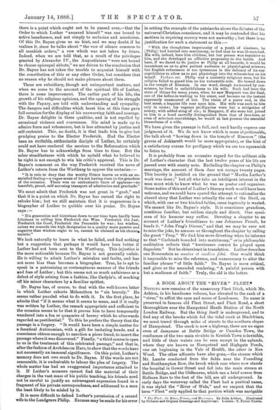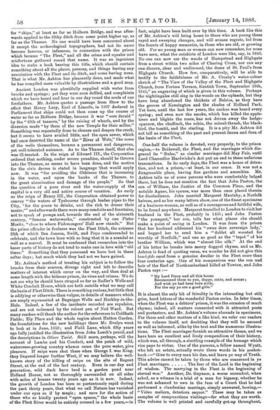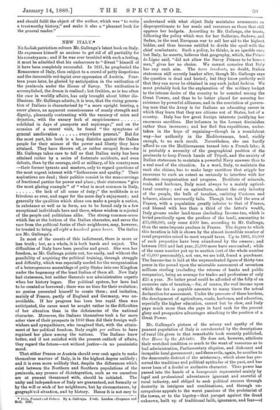A BOOK ABOUT THE " RIVER " FLEET.*
NOTHING now remains of the unsavoury Fleet Ditch, which Mr. Ashton, in his handsome volume, has elevated to the rank of a "river," to afflict the eyes and noses of Londoners. Its name is preserved in famous old Fleet Street, and Fleet Road, a short thoroughfare near the Hampstead Heath Station of the North London Railway. But the thing itself is underground, and to find any of the brooks which fed the tidal creek at Black friars, we must travel through miles of streets to the southern elopes of Hampstead. The creek is now a highway, there are no signs even of dampness at Battle Bridge or Camden Town, the confluence of the two main rivulets in Kentish Town is invisible, and little of their waters can be seen except in the uplands, where they are known as Hampstead and Highgate Ponds, one set beginning in the Vale of Health, the other in Ken Wood. The other affluents have also gone,—the stream which Mr. Lambe conducted from the fields near the Foundling and Southampton Row, the brook which rose where now stands the hospital in Gower Street and fell into the main stream at Battle Bridge, and the Oldbourne, which ran a brief course front Holborn Bars to the foot of the hill, are all underground. In early days the waterway called the Fleet had a poetical name, it was styled the "River of Wels," and we suspect that the term "Fleet" only applied to that portion which was navigable • The Fleet its River, Prison, and Marriages. By John Ashton. Illustrated by Pictures and Original Drawings and Bograsings. London: Fisher Unwin. for "ships," at least as far as Holborn Bridge, and was after- wards applied to the filthy ditch from some point higher up, as far as the Thames. No one would have been concerned about it except the archa3ological topographers, had not its name become famous, or infamous, in connection with the prison which became "The Fleet," and all the crime and squalor and misfortune gathered round that name. It was an ingenious idea to make a book bearing this title, which should contain something about all the places, persons, and things having any association with the Fleet and its ditch, and some having none. That is what Mr. Ashton has pleasantly done, and made what he has compiled more valuable by illustrations and a good map.
Ancient London was plentifully supplied with water from brooks and springs ; yet they were soon defiled, and complaints which we have heard and hear in our day vexed the souls of our forefathers. Mr. Ashton quotes a passage from Stow to the effect that Henry Lacy, Earl of Lincoln, in 1307 declared in Parliament that ships could not then come up the course of water as far as Holborn Bridge, because it was "sore decaid " by the "filth of tanners," by the raising of wharfs, and by the diversion made "by them of the new Temple for their milles." Something was repeatedly done to cleanse and deepen the creek, but it seems to have availed little, and the open sewer, which had once deserved the name of the "River of Wels," like some of the wells themselves, became a permanent and dangerous, yet well-tolerated nuisance. As to the Thames itself, that also was ill-treated. In the reign of Edward III., the Corporation ordered that nothing, under severe penalties, should be thrown into the Thames, as seems to have been done, and the motive for the civic decree is stated in language that would apply now. It was "for avoiding the filthiness that is increasing in the water, and upon the banks of the Thames, to the great abomination and damage of the people." So that the question of a pure river and the water-supply of the capital is a very old and active source of vexation. As early as the reign of Henry III., the Corporation obtained power to convey "the waters of Tyebourne through leaden pipes to the City, for the poore to drinke, and the rich to dresse their meate;' " and afterwards there were many conduits and fountains, not to speak of pumps and, towards the end of the sixteenth century, "famous waterworks," constructed by one Pieter Moritz, "close to where Fishmongers' Hall now stands." But the prime offender in foulness was the Fleet Ditch, the extreme filth of which Ben Jonson, Swift, and Pope condescended to celebrate, and the town bore with so long that it is a scandal as well as a marvel. It must be confessed that researches into the baser parts of history do not tend to make one in love with "old times." Something that they possessed we have lost in these softer days ; but much which they had not we have gained.
Mr. Ashton's method of treating his subject is to follow the brooks from their sources, diverge right and left to describe matters of interest which occur on the way, and then deal at some length with the hideous prison, its vices and crimes. We do not see why he should have strayed so far as Sadler's Wells and White Conduit House, which are both outside what we may call the basin of Fleet Ditch. There is something carious, but little that is edifying or otherwise than vulgar, in details of manners which are amply represented at Bagnigge Wells and Hockley-in-the- Hole. Indeed, a few of the incidents recorded are repulsive, and are not redeemed by the robust pen of Ned Ward. But many readers will thank the author for the references to Coldbath Fields; Ely Place and the whole region about Hatton Garden, the foundations for the new buildings there Mr. Evelyn went to look at in Jane, 1659; and Field Lane, which fifty years ago fully justified the illustration from John Leech's pencil, and the descriptions in Oliver Twist. Still more, perhaps, will the account of Lambe and his Conduit, and the patch of wild, watercress-growing country whence came the pure water, give pleasure. If snipe were shot there when George I. was King, they lingered longer further West, if we may believe the well- known story of the killing of snipe on the site of Regent Street, at the end of the last century. Even in our day and generation, wild duck have bred in a garden pond near Holland House, not so thoroughly surrounded on all sides with miles of houses twenty years ago as it is now. Indeed, the growth of London has been so portentously rapid during the past thirty years, that what we call Nature has vanished under our eyes as if by magic ; and save for the action of those who so kindly protect "open spaces," the whole basin of' the Fleet River would be entirely covered in a few years,—in
fact, might have been built over by this time. A book like this of Mr. Ashton's will bring home to those who are young these rapid and sweeping changes, and will arouse regrets, fed from the founts of happy memories, in those who are old, or growing old. For no young man or woman can now remember, for none have seen, what the outskirts of London were like, say, in 1840.
No one can now see the woods of Hampstead and Highgate from a street within two miles of Charing Cross, nor can any one discern, clear and undimmed, the dome of St. Paul's from Highgate Church. How few, comparatively, will be able to testify to the faithfulness of Mr. A. Crosby's water-colour sketch of "The View of the Valley of the Fleet and Highgate Church, from Fortess Terrace, Kentish Town, September 28th, 1845," an engraving of which is given in this volume. Perhaps the nightingales still sing in the woods on the uplands, but they
have long abandoned the thickets of Belsize, as they have the groves of Kensington and the shades of Holland Park. Yet here, until the last few years, the cuckoo was heard every spring; and even now the smoke, which has killed the apple- trees and blights the roses, has not driven away the hedge- sparrow, the chaffinch, the robin, the missel-thrush, the black- bird, the tomtit, and the starling. It is a pity Mr. Ashton did not tell us something of the past and present fauna and flora of the basin of the Fleet.
One-half the volume is devoted, very properly, to the prison region,—to Bridewell, the Fleet, and the marriages which dis- graced its "Rules," as similar marriages did May Fair, until Lord Chancellor Hardwicke's Act put an end to these nefarious transactions. In its early days, the Fleet was a house of deten- tion, and not a prison,—at least, in our sense. It was not a disagreeable place, having fine gardens and amenities. Mr. Ashton tells us of some persons who were comfortably lodged there, but he does not mention the fact that John Paston, the eon of William, the Justice of the Common Pleas, and the notable Agnes, his spouse, was more than once placed therein for disobedience. John married Margaret Mauteby, a Norfolk heiress, and as her many letters show, one of the finest specimens of a business-woman, as well as of a courageous and faithful wife, to be found anywhere. Margaret travelled to London to visit her husband in the Fleet, probably in 1465; and John Paston "the youngest," her son, tells her what places she should make a point of seeing in London. It was from the prison
that her husband addressed his "owns dere sovereign lady," and begged her to send him a " doblet all worsted for worship of Norfolk," and one as good as the " tepet " of his brother William, which was "almost like silk." At the end of his letter he breaks into merry doggrel rhyme, and as Mr.
Ashton is fond of quoting verse, we wonder he did not give this bond-fide carol from a genuine dweller in the Fleet more than four centuries ago. One of his companions was the son and
heir of the Earl of Northumberland killed at Towton, and John Paston says :—
" My Lord Porgy and all this house
Recommend them to you, dogge, catte, and mouse; And wish ye had been here stifle, For the say ye are a good gille."
It is almost the only bit of frivolity in the interesting but still grim, hard letters of the wonderful Paston series. In later times, when the Fleet was a debtors' prison, it was the occasion of much rhyme; indeed, all matters connected with it attracted poets and poetasters, and Mr. Ashton's volume abounds in specimens. For these and other matters of a like kind, we refer our readers to the volume itself, not doubting that they will be amused as well as informed, alike by the text and the numerous illustra- tions. The Fleet marriages furnish an attractive theme, and we have here an excellent and lively compendium of their history, which was, all through, a startling example of the homage which vice pays to virtue. One of the parsons, a fellow named Wyatt, who left an estate, actually wrote these words in his pocket- book :—" Give to every man his due, and learn ye way of Truth. This advice cannot be taken by those who are concerned in ye Fleet marriages The fear of the Lord is the beginning of wisdom. The marrying in the Fleet is the beginning of eternal woe." Another, Dr. Gaynam, a worse scoundrel, when asked, as a witness in a trial of a man for bigamy, whether he was not ashamed to own in the face of a Court that he had performed a clandestine marriage, simply answered, bowing,— " Video meliora, deteriora sequor." These may be taken as samples of compunctious visitings—for what they are worth. The volume is well printed and carefully got-up throughout, and should fulfil the object of the author, which was "to write a trustworthy history," and make it also a "pleasant book for the general reader."








































 Previous page
Previous page